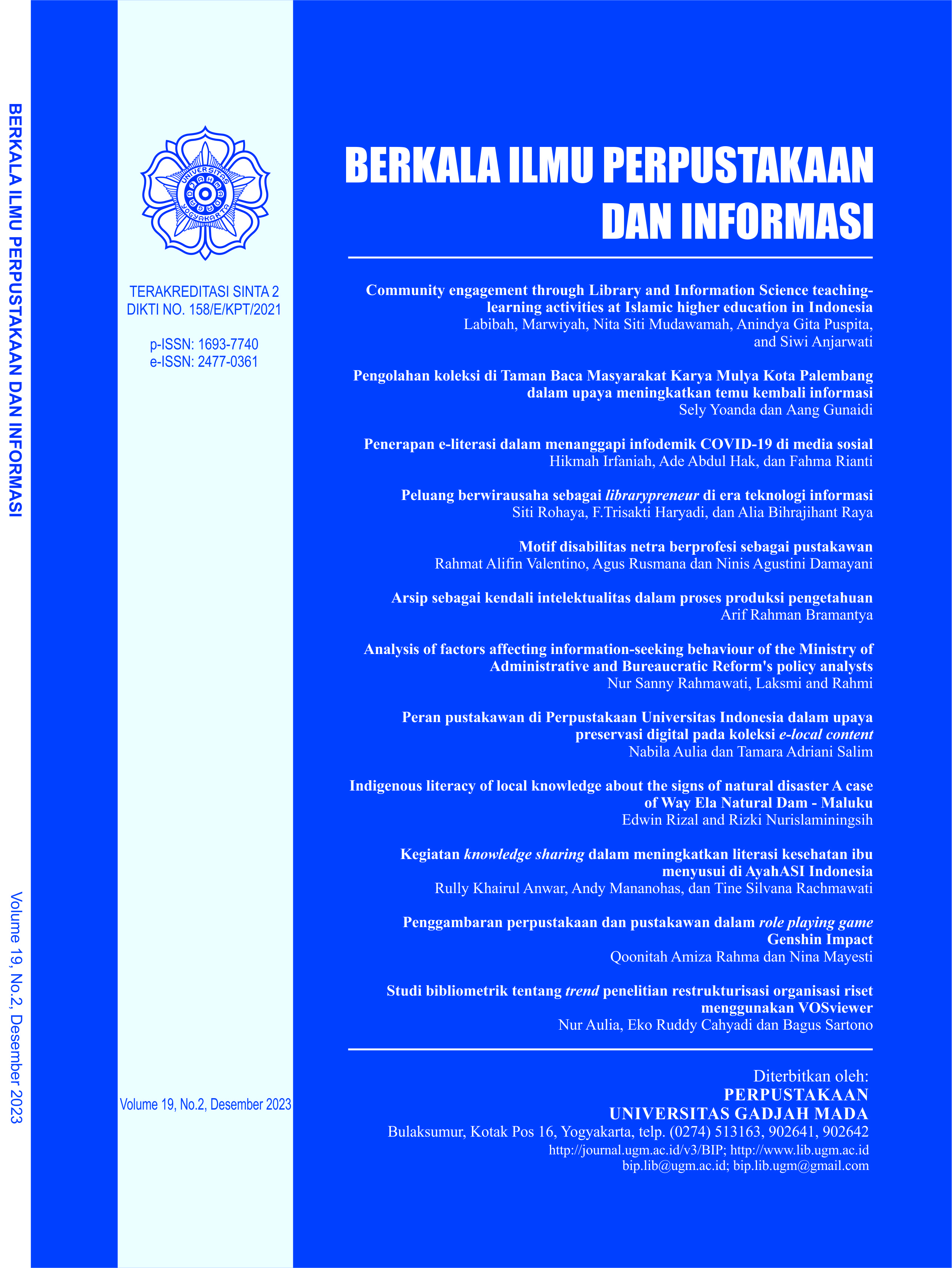Pengolahan koleksi di Taman Baca Masyarakat Karya Mulya Kota Palembang dalam upaya meningkatkan temu kembali informasi
Abstract
Introduction. The number of collections at the Karya Mulya Community Reading Center or Taman Bacaan Masyarakat (TBM) Palembang City continue to increase. It is necessary to evaluate the collection the efficient collection management that will influence information retrieval and increase public interest in reading.
Data Collection Methods. This study used a qualitative research method with a descriptive approach.
Data Analysis. The data analysis was conducted descriptively through several stages including data reduction, data presentation, and conclusion/data verification.
Results and Discussion. TBM Karya Mulya Palembang City has not carried out a systematic collection processing. The current stages of collection processing at TBM Karya Mulya Palembang City consist of inventorying, classifying children, adolescents and adults reading books, stamping collections, and shelving. This evaluation in a collection processing model at TBM Karya Mulya Palembang City lead to the better collection management based on library collection processing standards.
Conclusion. The TBM collection processing model of Karya Mulya Palembang City can be a reference in collection processing to facilitate information retrieval.
References
Aelbrecht, P. S. (2016). ‘Fourth places’: The contemporary public settings for informal social interaction among strangers. Journal of Urban Design, 21(1), 124–152. https://doi.org/10.1080/1357 4809.2015.1106920
Diana, W. , Razak, A. R. , & Said, A. (2019). Sistem pengelolaan Taman Baca Masyarakat di Kabupaten Barru. Kolaborasi: Jurnal Administrasi Publik, 5(1), 79–93. https://doi.org/10.26618/kjap.v5i1.2044
Elita, I. N., & Supriyanto, A. (2020). Peningkatan minat baca peserta didik melalui gerakan literasi sekolah. Prosiding Seminar Nasional Arah Manajemen Sekolah Pada Masa Dan Pasca Pandemi Covid-19, Fakultas Ilmu Pendidikan Universitas Negeri Malang, 106–113. http://conference.um.ac.id/index.php/apfip/article/view/391
Grabe, W., & Stoller, F. L. (2019). Teaching and researching reading. Taylor & Francis.
Hapsari, Y. I., & Purnamasari, I. (2019). Minat baca siswa kelas V SD Negeri Harjowinangun 02 Tersono Batang. Indonesian Journal of Educational Research and Review, 2(3), 371–378. https://doi.org/10.23887/ijerr.v2i3.22634
Hewi, L., & Shaleh, M. (2020). Refleksi hasil PISA (The Programme for International Student Assessment): upaya perbaikan bertumpu pada pendidikan anak usia dini. Jurnal Golden Age, 04(1), 30–41. https://doi.org/10.29408/goldenage.v4i01.2018
Karadeniz, A., & Can, R. (2015). A research on book reading habits and media literacy of students at the Faculty of Education. Procedia - Social and Behavioral Sciences, 174(1), 4058–4067. https://doi.org/10.1016/j.sbspro.2015.01.1155
Kyurova, V., & Koyundzhiyska-Davidkova, B. (2019). The community reading centers as a factor for development of the human potential. Revista 100-Cs, 5(1), 17–24. https://100cs.cl/index.php/cs/issue/view/20
Lanzty, T., Matlin, T., & Opdahl, J. (2020). Creating a library-wide collection management cycle: One academic library’s approach to continuous collection assessment. Journal of Library Administration, 60(2), 155–166. https://doi.org/10.1080/01930826.2019.1677092
Miles, M. B., Huberman, A. M., & Saldana, J. (2014). Qualitative data analysis: A methods sourcebook (3rd edition). SAGE Publications.
Miller, J. W. (2016). World’s most literate nations ranked. https://webcapp.ccsu.edu/?news=1767&data
Miller, J. W., & McKenna, M. C. (2016). World literacy: How countries rank and why it matters. Routledge. https://doi.org/10.4324/9781315693934
Muthtar, A., Hidayat, D., & Syahid, A. (2021). Pengelolaan taman bacaan masyarakat pelosok bumi di Kabupaten Karawang. Jurnal Pendidikan dan Pemberdayaan Masyarakat (JPPM): Collaborates With Asosiasi Pendidikan Masyarakat Indonesia (APENMASI), 8(2), 162–176. https://doi.org/10.36706/jppm.v8i2.15101
Organisation for Economic Co-operation and Development (OECD). (2019). PISA 2018 results combined executive summary volume I, II & III. https://www.oecd.org/pisa/Combined_Executive_Summaries_PISA_2018.pdf
Perpustakaan Nasional RI. (2018). Pedoman pengolahan bahan perpustakaan. Perpustakaan Nasional RI.
Selden, R. (2016). Practising theory and reading literature: An introduction. Taylor & Francis.
Septiana, A. N. A. (2021). Strategi Taman Baca Masyarakat (TBM) Karya Mulya dalam meningkatkan minat baca di Mata Merah Sematang Borang Palembang. [Skripsi]. Repository Universitas Islam Negeri Raden Fatah Palembang. http://repository.radenfatah.ac.id/18840/
Setyaningsih, W. H., & Kharismawati, M. (2020). The existence of the reading community and its effect in improving human resources quality. International Conference on Art, Design, Education and Cultural Studies, 470–483. https://doi.org/10.18502/kss.v4i12.7620
Suhendar, Y. (2014). Panduan petugas perpustakaan: Cara mengelola perpustakaan sekolah dasar (1st ed.). Prenada.
Suwanto, S. A. (2017). Pengelolaan TBM sebagai sarana meningkatkan minat baca masyarakat. ANUVA: Jurnal Kajian Budaya, Perpustakaan, dan Informasi, 1(1), 19–32. https://doi.org/10.14710/anuva.1.1.19-32
Taman Bacaan Masyarakat Lentera Pustaka Bogor. (2022). Survei tata kelola Taman Bacaan Masyarakat (TBM) Lentera Pustaka (Juni 2022). https://tbmlenterapustaka.com
Wahab, A., & Abdillah, F. (2019). Pelatihan pengelolaan Taman Bacaan Masyarakat Bening Saguling Foundation. COMM-EDU: Community Education Journal, 2(2), 162–167. http://dx.doi.org/10.22460/comm-edu.v2i2.2685
Yoanda, S. (2021). Analisis komponen koleksi berdasarkan instrumen akreditasi perpustakaan Institut Bisnis dan Informatika Indonesia. Jurnal El-Pustaka, 02(02), 71–85. https://doi.org/10.24042/el-pustaka.v2i2.10071
Copyright (c) 2023 Berkala Ilmu Perpustakaan dan Informasi

This work is licensed under a Creative Commons Attribution-ShareAlike 4.0 International License.
Berkala Ilmu Perpustakaan dan Informasi is licensed under a Creative Commons Attribution-ShareAlike 4.0 International License.
- Articles published in Berkala Ilmu Perpustakaan dan Informasi are licensed under a Creative Commons Attribution-ShareAlike 4.0 International license. You are free to copy, transform, or redistribute articles for any lawful purpose in any medium, provided you give appropriate credit to the original author(s) and Berkala Ilmu Perpustakaan dan Informasi, link to the license, indicate if changes were made, and redistribute any derivative work under the same license.
- Copyright on articles is retained by the respective author(s), without restrictions. A non-exclusive license is granted to Berkala Ilmu Perpustakaan dan Informasi to publish the article and identify itself as its original publisher, along with the commercial right to include the article in a hardcopy issue for sale to libraries and individuals.
- By publishing in Berkala Ilmu Perpustakaan dan Informasi, authors grant any third party the right to use their article to the extent provided by the Creative Commons Attribution-ShareAlike 4.0 International license.






